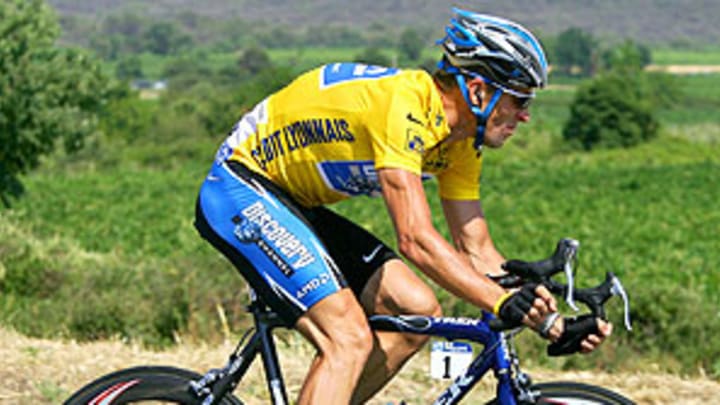Nike, Armstrong's most steadfast patron, now deems him unworthy


Before he survived cancer, Lance Armstrong was diagnosed with it, so we know he's had worse days than Wednesday, Oct. 17, 2012. But hopefully not too many. That was the day no fewer than five of the Texan's corporate sponsors announced that they intended to cut ties with him. Buried in that avalanche of sayonaras was Armstrong's own announcement that he was firing himself as chairman of his charity, the Livestrong Foundation. His stunning plunge from grace calls to mind a quote from The Sun Also Rises." Asked how he went bankrupt, the dissolute Mike Campbell answers: "Two ways. Gradually, then suddenly."
Allegations against Armstrong have been around since his first comeback, in 1998. There were two damning books by Irish journalist David Walsh. There was Armstrong's association with Michele Ferrari, the Italian physician banned for life by the US Anti-Doping Agency for numerous anti-doping violations. The accusations were serious. But, because they rolled in piecemeal, over the years; because Armstrong never tested positive for doping, and because people (including this reporter, until 2007) were so taken with his astonishing life story, he was bankable. His corporate sponsors stood by him.
All that changed with USADA's release last week of its detailed, ironclad, 202-page "Reasoned Decision," in which eleven former teammates and a host of other witnesses meticulously detail the Texan's use of performance enhancing drugs during his career.
That report was all it took to persuade many of Armstrong's former corporate BFFs to cut him loose. The first to toss him overboard may have been the most surprising. Nike chairman Phil Knight has traversed the Pyrenees in the team car behind Armstrong. The company's Beaverton campus has a building named after him. Not for long. Citing the "seemingly insurmountable" evidence in the USADA report, lamenting that Armstrong had "misled" them for more than a decade, Nike execs cancelled his contract.
Following the swoosh to the door were Radio Shack, Giro helmets, and Anheuser Busch (recall the Texan feigning bonhomie with actors in his spots for Michelob Ultra). As Wednesday wore on, cycling fans wondered: What will Trek do? The Texan had ridden the company's bikes to seven Tour titles. Would it stand by its man?
It would not. Late in the day, Trek announced on its website that it was "terminating our long-term relationship" with Armstrong, although -- like Nike -- the company vowed not to slack off in its support of the Livestrong Foundation and its initiatives.
George Hincapie served for years as Armstrong's most trusted lieutenant, his consigliere. Big George's decision to spill his guts to USADA investigators stood out to me as Amrstrong's "Et tu, Brute?" moment. But Nike's throwing him overboard is no less remarkable -- particularly when one considers the company's long history of co-dependent relationships with disgraced athletes that it hasn't jettisoned: Kobe Bryant, Ben Roethlisberger, Tiger Woods and renowned cellphone seducer, Brett Favre.
It's been evident for years that Armstrong didn't win all those Tours "pan y agua," as the Spanish say -- on bread and water. But so many of his blinkered, true-believing, yellow-braceleted fans here in America were willing to suspend disbelief, to ignore the ever-growing mountain of circumstantial evidence, that his brand retained much of its mojo. Not all of it, but a lot of it.
USADA's bombshell changed the calculus, kicking off that stampede to the exits. The Cancer Shield is officially kaput.
I first heard that term from longtime Lance nemesis Betsy Andreu, whom the Armstrong camp consistently characterized as an unhinged liar, and who now stands completely vindicated. She was referring to the force field that protected the Texan for so many years, the good will he'd amassed both by beating cancer, then devoting his life to "raising awareness" of it. The means to that nebulous end was his Foundation, which may or may not have commenced its search for a new chairman.
Yes, Armstrong has been spending fortunes in retainers to lawyers and spin doctors. But this kiss-off from Nike marks a new phase in his fall. This is when he truly starts hemorrhaging money. BusinessWeek estimates that yesterday's exodus of sponsors alone could cost Armstrong $30 million a year.
Other, smaller hits lurk on his horizon. In 2004, SCA Promotions underwrote a $5 million bonus to Armstrong, for winning his fifth straight Tour. When questions arose about whether Armstrong had doped to win, SCA refused to pay. Armstrong sued, and got his bonus. A lawyer representing SCA told the New York Times last week that the company would be going after Armstrong to recoup that money.
"He basically said that we were scum and how dare we criticize him," said the lawyer, Jeffrey Tillotson, who looked forward to pointing out to the Texan "that he didn't get away with it forever and, by the way, 'You owe us $7.5 million.' "
Working against higher odds is ex-Armstrong teammate Floyd Landis, who is pursuing a civil whistleblower case brought under the False Claims Act. Landis is alleging that some of the tens of millions of dollars the government spent on sponsorship contracts for the US Postal Service team was spent on doping products. (Landis would get a share of any money clawed back by the government).
Meanwhile, executives at Oakley, among others, must now decide whether their relationship with the Texan is doing their company more harm than good. The stakes are high, and Armstrong stands to lose more than his reputation.
